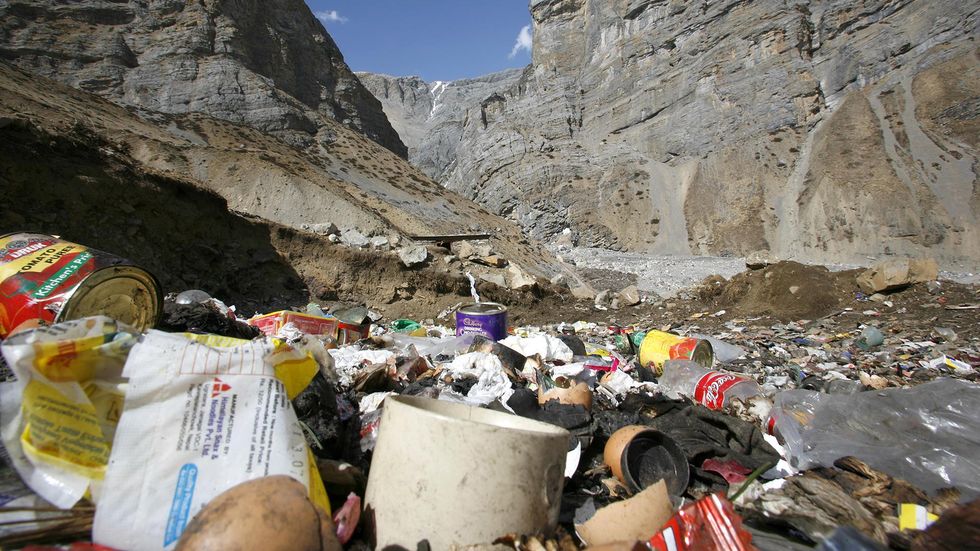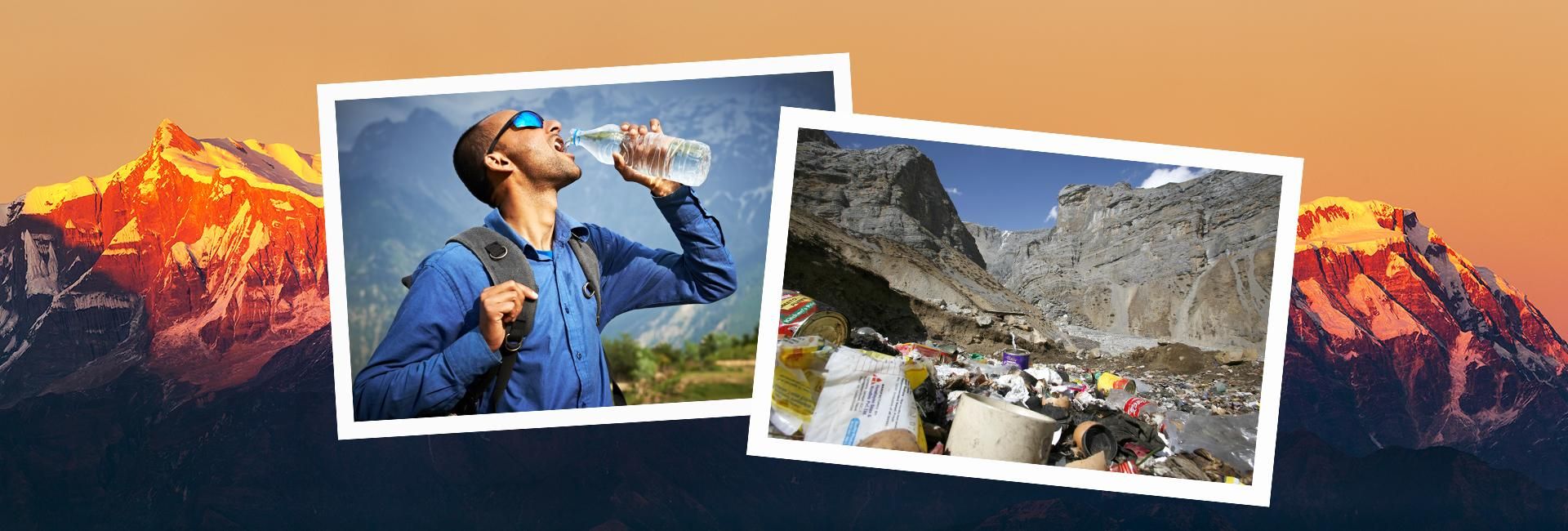A farmer dug a hole in the forest eight feet deep and still found litter. The solution is simple and it lies with us.
High above the bustling communities and polluted air of India are the Himalayas, a holy land of divine peaks, vast blue skies, sacred lakes and celestial glaciers that gleam under the unfiltered light of the Sun and Moon.
It is rightly said that if the Ganges River is the mother, then the Himalaya Mountains are the father. One nurtures and nourishes, the other provides and protects.
Famously known as God’s home, the highest mountain range on Earth stands as a protective shield for northern countries from the cold monsoon winds of the Indian Ocean and Arabian Sea. It is a rich biodiversity hotspot, home to more than a 100 endangered species, supplying fresh water to more than 20 per cent of the world’s population and producing hydroelectricity for the Indian subcontinent.
For centuries, the Himalayan landscape has attracted the interest not only of meteorologists, ecologists and scientists but also hikers and climbers keen to scale the heights of the Himalayas. Tourists from all over the world are lured by its transcendent beauty.
Buddhist and Hindu religions consider the Himalayas as the source to recharge their “spiritual heat”. With the stress and burnout index of modern life rising, interest in Eastern spirituality is booming.
In Leh, a small town in Ladakh, an estimated 30,000 plastic water bottles are dumped every day.
KN Vajpai, an environment specialist at Climate Himalaya, told Business Insider that interest has come at a price, with tourism across the wider Himalayan region spiking by almost 60 per cent since the 1990s. In Nepal, the rise in tourist arrivals is more than 300 per cent over that period.
The wider region entices more than 700,000 tourists a year, not just to hike but to “find themselves” by disconnecting from reality, quite literally. When they return home, they leave behind their rubbish along with their worries and distress.
The beautiful trails through snow covered mountains, fertile valleys, and the pure water from the world’s highest peaks, are now tainted by piles of garbage. Litter has become a common sight.
As well as ruining the views, the garbage raises concerns for local public health and environmental pollution. It is much harder to manage solid waste in this region than in the urban lowlands, due to the remoteness, extreme climate and absence of rubbish bins and other government waste collection services.
Sujal Parikh, a social activist spearheading ecological tourism in the Himalayas, said “nature provides us with everything to survive.” The “necessities” we are accustomed to today are simply a convenient replacement of what the nature already provided. Modernisation has made us selfish in that way. We take from nature but do not give back. Worse yet, we pollute it with industrialised waste.
“The Himalayas are huge so it is difficult to keep track of littering and people litter there due to lack of accountability,” Parikh said.

Devanshi Asher, a documentary filmmaker and photographer, made it her mission to track the litter build-up. For four years, she lived on the mountain range, witnessing the changes and closely monitoring the impact of litter on the ecologically-fragile region. She has produced a documentary, Himalayas to Sea, Plastic Free, for National Geographic channel, to be released at a future date.
“The documentary aims to educate people and create a behavioural change in the waste generation system,” Asher said.
She described the worldwide waste issue as like a bathtub filled to the brim with the tap still running. Current efforts to solve the waste crisis are akin to trying to empty water from the tub with a spoon.
A solution to the Himalayas, and the wider world’s waste problem will require every person to make a conscious effort to combat it.
“The [documentary] project made me realise that there is so much knowledge in waste and I was believing in myths till now — like all plastic bottles are recycled. I joined the project to learn myself and teach others.”
In Leh alone, a small town in Ladakh, west of Nepal, an estimated 30,000 plastic water bottles are dumped every day.
“The crazy thing is, the tourism packages being sold to tourists include 20 to 30 plastic water bottles. Like, you are in the mountains. You have access to fresh water streams and you can trust the water sources,” Asher said.
It’s funny that people are going to the mountains to be with nature and move away from their comfort zones but are so accustomed to the modern ways, they do not realise how their consumption habits impact their surroundings.

The impact of humans on the Himalayan ecology has become clearer over the past two years of COVID-19 lockdowns and travel restrictions. The break from regular human activities gave nature time to heal. Flora and fauna rejuvenated worldwide. While the break was good news, Asher expects things to eventually return to normal and tourism is predicted to boom in the Himalayas.
“With COVID, so many things have been introduced to our lifestyle such as sanitisers, disinfectants and masks, all extra chemicals and plastic that are also going into the ground and water, circling back into our systems. Imagine a forest where people threw trash. Over time, the waste disintegrates because of rain and nature, seeping through the soil. This waste will eventually be thrown back out,” Asher said.
The same soil will provide plants and vegetables for humans, but the nutritional value of our food will be impacted by the spoiled soil, she adds,
“The same thing with water, if you are adding chemicals to the source of water, you are changing the chemistry of the water which is harmful for our bodies.”
The Himalayan region is a major source of fresh water for India, it is important to maintain the purity of what eventually we will consume.
Asher recalled an anecdote she heard while making the documentary to illustrate her point. “A man trying to revive the forest, dug eight feet and yet found trash. A landslide in the same area displaced soil which was found to contain trash from the 1990s.”
While making the documentary, Asher lived as a local for four years. In doing so, she realised how modernisation has programmed us to expect instant gratification and convenience.
“During winters, I walk a kilometre with canister to get water from a hand pump. This lifestyle humbles you and certainly changes you. The landscape is such that you learn a lot about yourself.”
“I have observed that tourists do not adapt, they want their comfort even there. Instead of buying plastic bottles, why not just carry a flask? It’s the mindset game,” she said.
'The Himalayas are huge so it is difficult to keep track ... people litter there due to lack of accountability.'
Mahatma Gandhi once said “faith is like the Himalaya mountains which cannot possibly change.” Would the way humanity has changed the face of God’s Home for the worse shake his faith in humanity?
“When you think about it, the solution is so simple and right in front of your eyes but we don’t want to do it because of the whole sense of convenience and instant gratification,” Asher said.
For Parikh, the answer lies in addressing consumption. “What I have learnt is all of us need to consume consciously. Small gestures lead to big impacts. It has to be a global effort.”
Asher crisply sums it up: “This planet has survived everything before us and yet provided for us. Nature finds a way to revive itself, but we won’t survive. We will be put through hell by global warming.”
Over the four years she researched her documentary, Asher said she saw locals were initially part of the problem due to low awareness but they have seen the impact on their land and are now more conscious of their behaviour.
“ I visited Nagaland [in north-east India] where they wrap their food in banana leaves and carry bamboo tiffins. They don’t rely on packaged ingredients, they source from nature and that is how it is supposed to be.
“The tourist need to learn and adapt from the locals when they are there.”






Afraid of an egg: the tyranny of living with social media's body standards